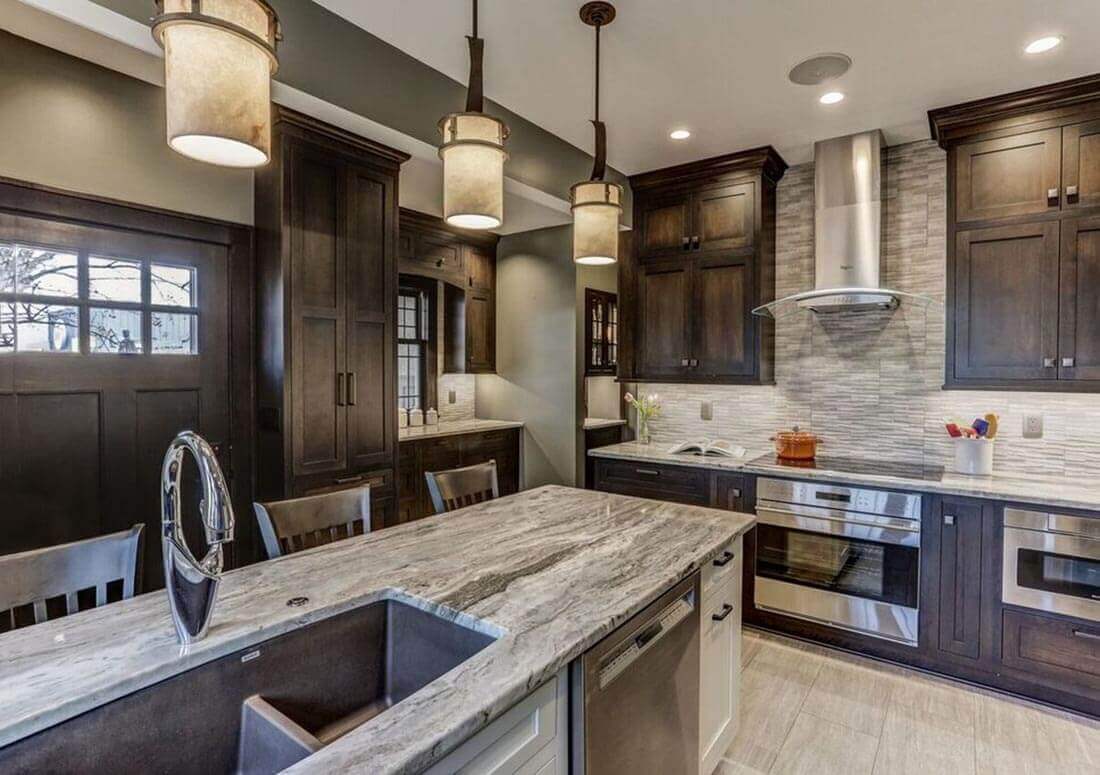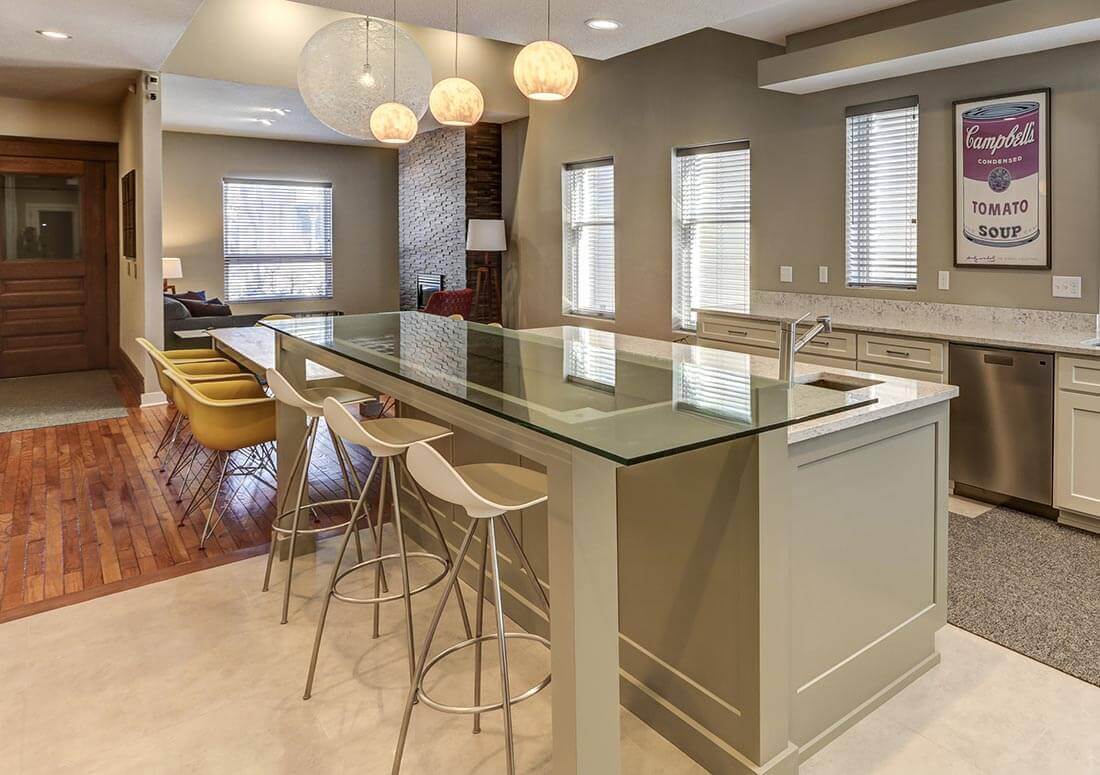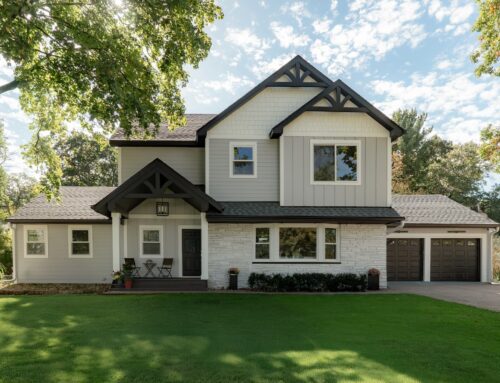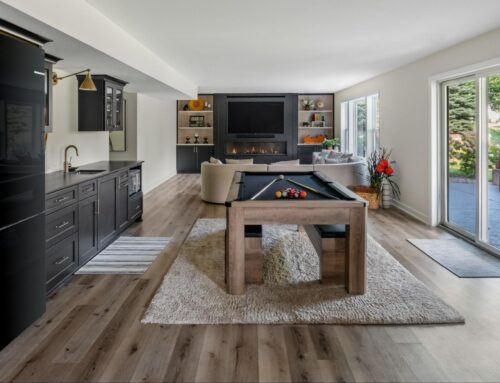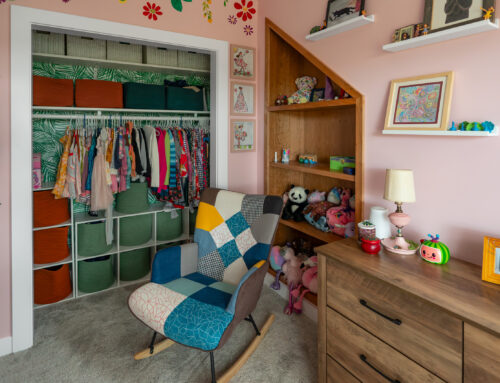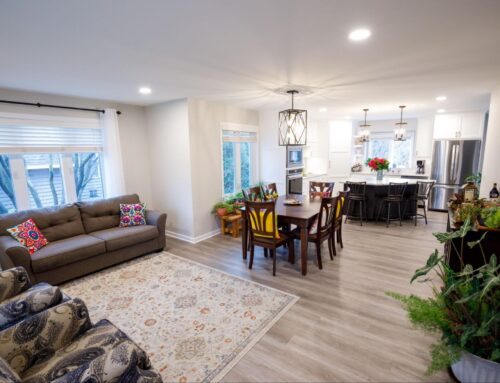Best kitchen countertop material to choose from during a kitchen remodel Tips on how to choose the best kitchen countertop material when remodeling your Twin Cities kitchen.
How to Choose the Best Kitchen Countertop Material For Your Home
Homeowners in the Twin Cities have a wealth of countertop materials, colors, and patterns to select from when choosing the best kitchen countertop option for a newly remodeled kitchen.
We know that this aspect of your kitchen remodeling project is an important part of kitchen décor; it matters a lot what material, finish and design you choose for your countertop. The countertop is an essential component of every kitchen design. That is why learning about the top-rated kitchen countertop materials available is important. It is the surface that a lot of daily activities happen on, but more than that, the countertop is the foundation of a kitchen’s décor when doing a kitchen renovation. As a large and eye-catching surface, it sets the tone and feel of a kitchen space.
Today’s discerning homeowners are seeking a bit more character in their kitchen countertops. Thankfully, technology has advanced along with the new home remodeling trends and offers more creative solutions then we’ve ever had before.
How Top-Rated Kitchen Countertop Materials Rank
Trends in kitchen countertops for 2019 are focused on the look of real stone and practicality. There are pros and cons with each countertop option. Kitchen interior home designers have their list of favorites. NKBA released the percentages per type of kitchen countertop surface that these designers commonly specify:
1. Quartz—88%
2. Granite—83%
3. Marble—43%
4. Solid surface—43%
5. Butcher block—35%
6. Other wood—29%
7. Other stone—26%
8. Recycled countertops—22%
9. Stainless steel—17%
10. Concrete—13%
11. Glass—11%
12. Tile—6%
The right material can make your whole kitchen feel luxe or relaxed. We recommend focusing on quality and function. Let’s talk in detail about each one. When reviewing the top-rated kitchen countertop materials, remember that one may be more suited for your home than another.
What is The Best Kitchen Countertop Material for Your Money?
Your home is uniquely yours. How you function optimally in it, budgets, and the personal style you choose plays much into which material you will be pleased with in the long run. Whether you are wanting a larger eat-in kitchen space, or an outdoor kitchen, or are wanting to transform an older home’s kitchen into a more modern and function space, the material you choose can help achieve your desired result. Seeing how and why one material is ranked higher or lower is helpful. Below, we provide more details to help you make an informed choice.
1. Quartz Countertops – 88%
While its beginnings are from genuine quartz, this countertop material is categorized as man-made when resins are added to fabricate the product. Cambria and Silestone are two of the best-known quartz products. Numerous color options and edge treatments are available for purchase. Buyers will find “super slabs” for a premium price as they meet the need when a larger quartz slab is needed for the installed countertop.
One advantage of using quartz is that it doesn’t need sealing. Most home remodelers use some type of undermount sink. It has numerous advantages over granite; the primary one is it’s impervious to stains and stands up to acidic foods. It’s also remarkably more scratch and chip resistant, which speaks of longevity. For individuals who are environmentally conscious, it is a greener choice because it’s made from waste stone and therefore doesn’t require mining slabs or shipping them around the globe, both of which are carbon-intensive procedures for natural granite and marble countertops.
Some of the more familiar brand names are Silestone, Zodiaq, Cambria, and Caesarstone. You should expect the costs of a quartz kitchen counter top to run between $70 and $85.00 per square foot. Like granite, it has a honed or gloss finish.
2. Granite Countertops – 83%
One of the key qualities of granite is its ability to be durable regardless of changes such as when hot and cold items are placed on it. Its top advantages are that it is hard to damage and a breeze to clean. One downside brought up by Quartz manufactures is the fact it needs to be sealed. Otherwise, its surface is prone to risks of bacteria invasions. However, sealing is a simple task and quick to do. Many cleaning products have sealers built right in. For the most part, raw granite slabs for purchase are limited to 5’ x 9’, which are smaller pieces than you will often find in the market in Quartz. Many selections are priced in the $40 to $65.00 range per square foot but can run more when selecting more unique, harder to acquire colors. A wide variety of countertop edges are typically available. The typical application is with undermount sink.
3. Marble Countertops – 43%
This material is known as a softer natural stone. This may not the best option for kitchens because of how yielding it can be if something hits it with a thud. However, it can add a gorgeous element that often is featured in showrooms. It is important to make sure a good sealing is completed before using.
4. Solid-Surface Countertops – 43%
While quartz and solid surface countertops both provide immense value, they rank very differently from one another. Typically, quartz rivals with granite and solid surface countertops parallel more closely with laminates. Quartz is made up of 85-95% crushed quartz with a resin binder while solid surface—also man-made—consists of acrylic or polyester plastics. Corian, known as the original solid surface counter, is composed of approximately 33% acrylic resin (PMMA) and about 66% natural minerals.
According to thespruce.com, “It was introduced in 1967 by DuPont under the brand name Corian, though there are currently other major brand names offering the material, including Avonite and Swanstone. It is a decided improvement over laminate countertops, and over the older plastic material commonly called cultured stone”.
It is not a “single substance” kitchen surface and neither is it all-natural. So, if a purely natural product matters to you, this is an aggregate of polymers and minerals, and you should look at natural stone slab options instead.
5. Butcher block/Wood Countertops – 35%
Although this offers an attractive-looking option, Titus Contracting hasn’t found it to be particularly sanitary. It’s very susceptible to bacteria and easily damaged. Combined, it means that a homeowner should be prepared to manage its high maintenance needs. We recommend a fresh oil finish is applied every 3-9 months.
6. Other wood (Laminate) Countertops – 29%
Laminate countertops are made of a mixture of wood and paper products held together with glue and resin. They are the least expensive of the kitchen top options. Formerly, we used this material a lot, but today, it is rarer for Titus Contracting Inc. to be involved with a kitchen upgrade that uses laminates. High Definition laminates have come a long way in giving the laminate a very real (stone like) look. There are all kinds of edge treatments available, some that give the top an even more realistic stone-like appearance. Post Form is a type of laminate top where machinery is actually used to roll the material to give it a more stone-like look as well.
Laminate countertops typically will run in the $20 – $30.00 per square foot range, and drop in sinks are typically used with them. One advantage that homeowners like about laminate is that you don’t have to wait to have the tops fabricated after your cabinets are installed. Largely, the tops listed above are templated after the kitchen cabinets are installed. Then, the tops are typically installed 1-3 weeks following fabrications. This obviously prolongs a project – as many things cannot happen until the tops are installed.
7. Other Stone Countertops – 29%
Soapstone and Limestone are two additional classic materials. Limestone appeals to the eye seeking a natural-stone look without heavy veining or graining, so it has a clean and uncomplicated look. As well, it resists heat. Soapstone tends to take on nicks, cuts, and scratches faster than other materials, and some stains are challenging to resolve. This makes it a less popular choice.
Engineered stone is a composite material that is used in kitchens. It is made of crushed stone bound together by an adhesive, (most often with polymer resin, with a few more recent versions using cement mix). This category includes engineered quartz, polymer concrete and engineered marble stone. The application of these products for a kitchen counter depends on the original stone used.
8. Recycled countertops – 22%
There are several manufacturers who specialize in recycled quartz, Vetrazzo, or glass countertops in order to offer a great alternative to the standard materials. For the remodeling budget-conscious kitchen project, if you go with Vetrazzo, there are few chances of hidden surprises. It’s made in the USA from 85% recycled post-consumer glass and a non-resin binder of Portland cement, Vetrazzo is a green material countertop that doesn’t contain any petroleum products or toxic chemicals.
Given its weight, it is one more reason to not attempt installing this yourself. Our home remodeling crews have the proper equipment, experience, and training that most homeowners don’t have, which could leave you with a very sore back.
9. Stainless Steel Countertops – 17%
Many consider a stainless steel kitchen countertop as classy and professionally elegant. Its flair appeal fits a sleek, contemporary home look, but it is not as “stainless” and durable as the name implies. It will stain and corrode, and, like concrete, demands a significant amount of care and maintenance. The popularity of stainless has grown and prompted its expanded use from professional kitchens into more residential kitchen remodels.
Sixteen-gauge stainless steel is used for typical home kitchen applications, whereas the thicker fourteen- and twelve-gauge steel is commonly found in heavily-used restaurant kitchens. It begins as a raw material, which makes it easy to shape into almost any dimension you desire. While you may gain a highly unique and showstopping kitchen, be prepared for its outrageous price tag. It’s obtainable at $100-$200 per square foot.
10. Concrete Countertops – 13%
Its less often that our home renovation team gets a call for this, but there are individuals who like it. Concrete adds a solid and modern tone to a home’s design and there are some creative finishes available. As a newer material choice in the lineup of kitchen counter choices, concrete is totally a custom surface. If you have your heart set on a specific shade of stone, then you can more easily obtain that with concrete, along with a host of texture options.
One advantage is that it’s a “poured material,” meaning that we can form it into any shape you desire and then you add your choice of color. However, in our experience, its maintenance is more challenging, because it must be sealed on a regular basis. Concrete is a heavy material, similar to solid granite. Note that concrete counters are poured and cured before being installed in your house; they are not produced on-site.
Homeowners may be surprised at how expensive it can be. Considering that many consider concrete as a very common building material used in a home’s walkways and patios, it hits the $100/square foot mark when used in kitchen applications.
11. Glass or Recycled Glass Countertops – 11%
This countertop material is gaining popularity. Partly because it is environment-friendly to recycle glass for a good use, but also because homeowners love the vast range of color choices that are easy to find on the shelves. This material is also fabricated similar to other solid surface tops and doesn’t require sealing. It typically is more expensive, running between $75 and 110 a square foot.
12. Tile Kitchen Countertops – 6%
If an open concept kitchen design resonates with you, some consider tile countertops an ideal choice to accompany stainless steel appliances, a farmhouse sink, and perhaps recessed-panel cabinets. Tile works well when used as a kitchen island surface and can be applied behind your stove as well for a themed look. It is easy to cut and fit for rounded edges and around drop-in sinks.
Tile can also echo a certain culture, for example, if you have a love of Spanish Colonial architecture, many kitchen tiles are available that help make this style statement. A very simple, clean vintage look is achieved with tile countertops and white appliances if you have a historic home and wish to reflect that era.
Kitchen tiles with exotic finishes resembling wood, marble, brick or natural stone have grown in popularity as homeowners seek something different from the ordinary. The difference in style between the countertop and the backsplash tile can provide a surprisingly harmonious result. Our designers might recommend a countertop tile that is toned down just a bit to best highlight your backsplash, with both complementing each other perfectly.
One negative aspect of tile is the cleanup. With the grout joints, you tend to have more work keeping things clean and maintaining the tops. Tile can also chip which is a downfall, but if they have extra pieces they can be replaced. When doing this the grout may not match something that has aged. Countertop prices using tile typically run in the $25 – $40.00/SF range.
For an additional read, Consumer Reports has a helpful article titled “Pros and cons—and costs—of 10 countertop materials“ and view our PDF on How to Choose Kitchen Counter Top Materials.
Conclusion
The countertop remains a significant aspect in beautiful kitchen décor. Through the generations, we have gone from style to style, as homeowners love something fresh yet functional. We can help you obtain that perfect look for your main cooking space. You have an almost endless selection of materials, styles, sizes, and finishes to choose from; our partnership will ensure that you are pleased with your end result.
For now, less color-centric countertops seem to be winning in kitchen trends. The modern kitchen in 2019 is predicted to feature neutral colored countertops with thin “delicate” slabs and sleek sink lines that are beautifully integrated. Follow our blog to gain future insights about top-rated kitchen countertop materials ideas and updates.

